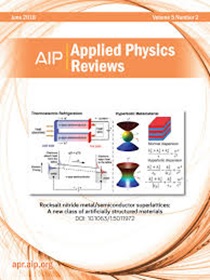半导体胶体量子阱中的室温激子-极化激子激光
IF 11.6
1区 物理与天体物理
Q1 PHYSICS, APPLIED
引用次数: 0
摘要
激子-极化激子激光是由激子-极化激子玻色-爱因斯坦凝聚(BEC)产生的自发相干发射,由激子-极化激子模拟散射促进。与传统的光子激光器不同,这个过程不需要粒子数反转。II-VI/III-V胶体半导体纳米晶体以其狭窄的发射线宽和可调谐的发射波长而闻名,在显示器,led和探测器中有广泛的应用。然而,用这些材料实现激子-极化激子激光仍然具有挑战性。在这项工作中,我们研究了具有不同厚度的CdSe胶体量子阱(CQWs)中激子结合能的变化,并证明了CQWs在fabry - p本文章由计算机程序翻译,如有差异,请以英文原文为准。
Room-temperature exciton-polariton lasing in semiconductor colloidal quantum wells
Exciton-polariton lasing is the spontaneous coherent emission resulting from exciton-polariton Bose-Einstein condensation (BEC), facilitated by polariton-polariton simulated scattering. This process does not require population inversion, unlike conventional photonic lasers. II-VI/III-V colloidal semiconductor nanocrystals, known for their narrow emission linewidth and tunable emission wavelength, find broad applications in displays, LEDs, and detectors. However, achieving exciton-polariton lasing with these materials remains challenging. In this work, we investigate the exciton binding energy variations in CdSe colloidal quantum wells (CQWs) with different thicknesses and demonstrate the integration of CQWs in a face-down aligned configuration within a Fabry–Pérot cavity. This alignment enhances the exciton-photon coupling, leading to increased Rabi splitting energy and stronger coupling compared to randomly oriented CQWs, thereby facilitate exciton-polariton condensation. Due to the enhanced coupling with cavity fields and large exciton binding energy, we report the first observation of room-temperature exciton-polariton BEC and exciton-polariton lasing from CdSe CQWs. By systematically tuning the exciton-photon detuning, we achieve wavelength-tunable polariton lasing from 530 nm to 549 nm, including spectral regions without conventional optical gain, extending lasing beyond the intrinsic emission of 4 ML CQWs. These findings establish CdSe CQWs as effective platform for polariton-based optoelectronics.
求助全文
通过发布文献求助,成功后即可免费获取论文全文。
去求助
来源期刊

Applied physics reviews
PHYSICS, APPLIED-
CiteScore
22.50
自引率
2.00%
发文量
113
审稿时长
2 months
期刊介绍:
Applied Physics Reviews (APR) is a journal featuring articles on critical topics in experimental or theoretical research in applied physics and applications of physics to other scientific and engineering branches. The publication includes two main types of articles:
Original Research: These articles report on high-quality, novel research studies that are of significant interest to the applied physics community.
Reviews: Review articles in APR can either be authoritative and comprehensive assessments of established areas of applied physics or short, timely reviews of recent advances in established fields or emerging areas of applied physics.
 求助内容:
求助内容: 应助结果提醒方式:
应助结果提醒方式:


